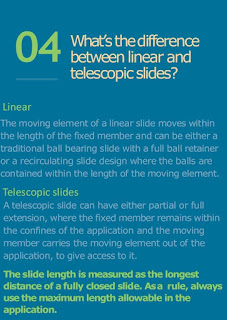/*! elementor – v3.18.0 – 20-12-2023 */
.elementor-widget-text-editor.elementor-drop-cap-view-stacked .elementor-drop-cap{background-color:#69727d;color:#fff}.elementor-widget-text-editor.elementor-drop-cap-view-framed .elementor-drop-cap{color:#69727d;border:3px solid;background-color:transparent}.elementor-widget-text-editor:not(.elementor-drop-cap-view-default) .elementor-drop-cap{margin-top:8px}.elementor-widget-text-editor:not(.elementor-drop-cap-view-default) .elementor-drop-cap-letter{width:1em;height:1em}.elementor-widget-text-editor .elementor-drop-cap{float:left;text-align:center;line-height:1;font-size:50px}.elementor-widget-text-editor .elementor-drop-cap-letter{display:inline-block} What’s the difference between linear and telescopic slides?
Linear: The moving element of a linear slide moves within the length of the fixed member and can be either a traditional ball bearing slide with a full ball retainer or a recirculating slide design where the balls are contained within the length of the moving element.
Telescopic: A telescopic slide can have either partial or full extension, where the fixed member remains within the confines of the application and the moving member carries the moving element out of the application, to give access to it.
The slide length is measured as the longest distance of a fully closed slide. As a rule, always use the maximum length allowable in the application.
#drawerslides #slide #telescopicslides #ballbearingdrawerslides #heavydutydrawerslides
.elementor-widget-text-editor.elementor-drop-cap-view-stacked .elementor-drop-cap{background-color:#69727d;color:#fff}.elementor-widget-text-editor.elementor-drop-cap-view-framed .elementor-drop-cap{color:#69727d;border:3px solid;background-color:transparent}.elementor-widget-text-editor:not(.elementor-drop-cap-view-default) .elementor-drop-cap{margin-top:8px}.elementor-widget-text-editor:not(.elementor-drop-cap-view-default) .elementor-drop-cap-letter{width:1em;height:1em}.elementor-widget-text-editor .elementor-drop-cap{float:left;text-align:center;line-height:1;font-size:50px}.elementor-widget-text-editor .elementor-drop-cap-letter{display:inline-block} What’s the difference between linear and telescopic slides?
Linear: The moving element of a linear slide moves within the length of the fixed member and can be either a traditional ball bearing slide with a full ball retainer or a recirculating slide design where the balls are contained within the length of the moving element.
Telescopic: A telescopic slide can have either partial or full extension, where the fixed member remains within the confines of the application and the moving member carries the moving element out of the application, to give access to it.
The slide length is measured as the longest distance of a fully closed slide. As a rule, always use the maximum length allowable in the application.
#drawerslides #slide #telescopicslides #ballbearingdrawerslides #heavydutydrawerslides
